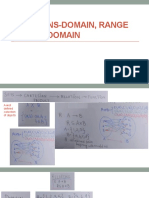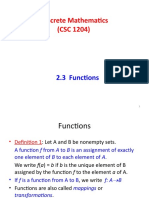0% found this document useful (0 votes)
47 views42 pagesLecture 16 Functions
Discrete structures can represent algorithms and their complexity. A function assigns each element of a set A to a unique element of a set B. The domain is set A and codomain is set B. A function is one-to-one if each element in the codomain has a unique pre-image, and onto if each element in the codomain is the image of some element in the domain. A bijection is a function that is both one-to-one and onto. The inverse of a one-to-one function assigns each element in the codomain to its unique pre-image in the domain.
Uploaded by
sajjadsho.mirzajiCopyright
© © All Rights Reserved
We take content rights seriously. If you suspect this is your content, claim it here.
Available Formats
Download as PDF, TXT or read online on Scribd
0% found this document useful (0 votes)
47 views42 pagesLecture 16 Functions
Discrete structures can represent algorithms and their complexity. A function assigns each element of a set A to a unique element of a set B. The domain is set A and codomain is set B. A function is one-to-one if each element in the codomain has a unique pre-image, and onto if each element in the codomain is the image of some element in the domain. A bijection is a function that is both one-to-one and onto. The inverse of a one-to-one function assigns each element in the codomain to its unique pre-image in the domain.
Uploaded by
sajjadsho.mirzajiCopyright
© © All Rights Reserved
We take content rights seriously. If you suspect this is your content, claim it here.
Available Formats
Download as PDF, TXT or read online on Scribd
/ 42
























































































